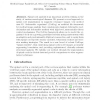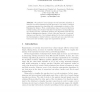47 search results - page 1 / 10 » A Framework for Tubular Organs Segmentation |
WSCG
2004
14 years 8 days ago
2004
Tubular organs (blood vessels and bronchial tubes), because of their anti-compact nature, generally appear randomly cross-sectioned in CT slices. Because of this, it's diffic...
MICCAI
2006
Springer
14 years 11 months ago
2006
Springer
Spinal cord analysis is an important problem relating to the study of various neurological diseases. We present a novel approach to spinal cord segmentation in magnetic resonance i...
CVPR
2006
IEEE
15 years 27 days ago
2006
IEEE
We present a novel approach to the segmentation and analysis of vasculature from volumetric medical image data. Our method is an adoption and significant extension of deformable o...
MICCAI
2005
Springer
14 years 11 months ago
2005
Springer
We present a novel technique for the automatic formation of vascular trees from segmented tubular structures. Our method combines a minimum spanning tree algorithm with a minimizat...
ECCV
2010
Springer
14 years 1 months ago
2010
Springer
Abstract. Image segmentation and figure/ground organization are fundamental steps in visual perception. This paper introduces an algorithm that couples these tasks together in a s...


